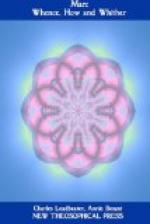If an animal is to progress, it must keep such a conformity ever secondary to a still more important element, namely, conformity or obedience to the laws of its own structure and being. This second element the mollusk and every creeping stage neglected, and the result of this neglect was stagnation or degeneration. Activity was essential to progress from the very structure and laws of development of the animal, while a great abundance of food was not. A life of ease, for the same reason, necessarily results in degeneration.
But you will ask, What becomes of Mr. Darwin’s theory of evolution, if obedience to the laws of individual being is more important than conformity to external conditions? Both are evidently necessary, and they are not so different as they may seem at first sight. They are really one and the same. Bringing out the best and highest there is in us, is the only true conformity to that which is deepest and surest and most enduring in our environment. That in environment which makes for digestion is almost palpable and tangible, that which makes for activity less so perhaps; but that which makes for brain and truth and right is intangible and invisible. We easily fail to notice it; and, unless we take a careful view of the course of development in the highest forms of life, we may be inclined to deny its existence. But it is surely there, if man is a product of evolution.
Each successive stage of animal life is not the preceding stage on a higher plane, but the preceding stage modified in conformity to the environment of that from which it has just arisen. Says Professor Hertwig[A]: “During the process of organic development the external is continually becoming an integral part of the individual. The germ is continually growing and changing at the expense of surrounding conditions.” Every stage thus contains the result of a host of reactions to a ruder and older portion of environment. And the higher we go the more has the original protoplasm and structure been modified as the result of these reactions.
[Footnote A: Hertwig: Zeit- und Streitfragen, p. 82.]
We have seen clearly that environment must be studied through its effect upon living beings. Viewed from any other standpoint it appears to be a myriad, almost a chaos, of interacting, apparently conflicting, forces. The resultant of some of these is shown by the animal at any stage of its development. And as the animal advances, the resultant determining its new line, or stage, of advance, includes new forces, to which it has only lately become sensitive. And thus the human mind, as the last and highest product of evolution, mirrors most adequately the resultant of all its forces. If we would know environment we must study ourselves, not atoms alone, nor rocks, nor worms.
Extremely sensitive photographic plates, after long exposure, have proven the existence of stars so dim and far-off as to be invisible to the best telescopes. Man’s mind is just such a sensitive plate; it is the only valid representation of environment.




